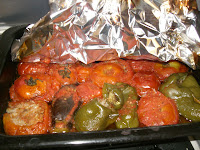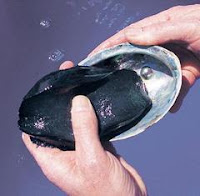

This is the king dish of Greek lenten fare. For this dish you need 8 medium tomatoes, 4-5 bell peppers and 4-5 medium aubergines. Slice the tops off the vegetables and put them aside. You will need them after filling the shells. If you are using the long variety of aubergine, slice the top off (and discard), and then cut off a thin slice on one side (keep it). You can also use courgettes (treat them similarly to the long aubergine), but I prefer not to as a matter of taste. Spoon out the flesh of all the vegetables, placing it all in a bowl (discard only the innards of the peppers).
Place them in a baking dish, making sure they all fit neatly. If there is still some space left, shell out some more vegetables of your choice and fill in the gaps. You can freeze the shells at this stage, so that you can save time when making this dish at a later date. The good news about the frozen shells is that they can be used as they are, and certainly mustn't be defrosted before use. Aubergine is best frozen in this way ( or in slices); it keeps its taste and texture when it is cooked immediately after being taken out of the freezer. Never thaw frozen aubergine, as it retains a lot of water, it turns soggy, and looks unappetising. There are three ways I successfully
freeze eggplant without it losing its taste: see my recipes for
moussaka and
papoutsakia.

For the basic filling you need:
1 large onion, grated
a bunch of finely chopped mint
a bunch of finely chopped parsley
a bunch of finely chopped fennel or dill
the flesh of 6 tomatoes, pureed
the flesh of 1 eggplant, finely chopped (optional)
salt, pepper, cumin and oregano to taste
Place the onion, aubergine pulp, mint, parsley, fennel, salt, pepper, cumin and oregano in a bowl. Using a blender, turn the tomato flesh into pulp, add 2/3 of it to the onion mix, then add 1/2 cup of olive oil, and mix everything well. Omit any herbs you don't have access to; these stuffed vegetables can be made with any herb favorites, although the ones I have listed are the traditional Greek ones.
And if you had decided to freeze the shells, you could now also freeze this mixture as is, to use it when you decide to cook this dish. The remaining pulp can also be frozen in a separate container to be used in the sauce that the vegetables will be cooked in. The bad news about the frozen mixtures is that you will need to defrost both of them well in advance when you do decide to make them. Unfortunately, rice does not freeze well, so you can't pre-fill the shells before you freeze them.



If you are not freezing it, and you're going to cook it now, add a tablespoon of rice for every vegetable shell (ie, approximately 20 tablespoons of rice for the 8 tomatos, 4-5 peppers and 4-5 aubergines). Mix the rice into the tomato mixture thoroughly. Now take a tablespoon and add one spoonful of rice mix into each shell. After all the shells have had a spoonful of rice added to them, repeat the process until all the shells are filled to just below the top. Don't fill the shells one at a time; it is important to dole out the mixture slowly, so that each shell gets its fair share of liquids. When all the shells have been filled (if you have any rice mixture left over, you can make
αγέμιστα. You can't freeze it because rice doesn't freeze well), put the tops back on the vegetables. Then pour the remaining tomato pulp over all the vegetables; drizzle some olive oil all over them, too. Now cover the whole dish with aluminium foil and cook it in a pre-heated oven (200C) for approximately one hour, or until the rice is cooked. You may need to check for this by opening up the foil, and taking a top off one of the vegetables to look at the rice. If it needs more doing, check that there is enough liquid in the tin to ensure it doesn't burn.To make this dish a little spicier, insert a small piece of sausage of your choice on top of each filled shell before you put the tops back on. Delicious! many cooks also add mince to the rice mixture; I never do, because I believe we eat enough meat as it is, so I never make yemista in this way (although I am partial to sausage).


Instead of using the caps of the vegetables to close them, try using
dolmades or
dolmadakia instead. Use whatever leaves are in season; I've even topped them with Cos lettuce. In the summer, most Greek cooks will hunt out anthous, the delicate little yellow flowers growing at the end of courgettes (zucchini). Cleared of their anthers (whose powdery orange dust stains anything that touches it), they make a stunning rice parcel hors d'oeuvre. For my family, to save cooking time, I often
top them with meat patties, and they cook very well.
To serve the vegetables, place three different stuffed vegetables on a plate, cut them into three or four pieces each, and spread a snall blob of Greek strained yoghurt over them. Heaven!
©All Rights Reserved/Organically cooked. No part of this blog may be reproduced and/or copied by any means without prior consent from Maria Verivaki.
MORE RICE RECIPES: Simple pilafi rice for children
Spanakorizo
Dolmadakia - dolmades
Yemista ki'ayemista








